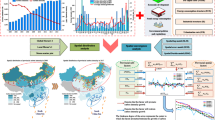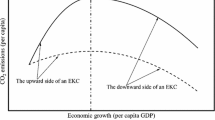Abstract
Is emission intensity of carbon dioxide (CO2) spatially correlated? What determines the CO2 intensity at a provincial level? More importantly, what climate and economic policy decisions should the China’s central and local governments make to reduce the CO2 intensity and prevent the environmental pollution given that China has been the largest emitter of CO2? We aim to address these questions in this study by applying a dynamic spatial system generalized method of moment technique. Our analysis suggests that provinces are influenced by their neighbours. In addition, CO2 intensities are relatively higher in the western and middle areas, and that the spatial agglomeration effect of the provincial CO2 intensity is obvious. Our analysis also shows that CO2 intensity is nonlinearly related to gross domestic product, positively associated with secondary-sector share and foreign direct investment, and negatively associated with population size. Important policy implications are drawn on reducing carbon intensity.


Similar content being viewed by others
References
Anderson T, Hsiao C (1982) Formulation and estimation of dynamic models using panel data. J Econ 18:47–82
Anselin L (1991) Handbook of regional and urban economics. In: Nijkamp P (ed), Volume 1: Regional economics (North-Holland, Amsterdam, 1986). Reg Sci Urb Econ 21(1): 143–156
Anselin L, Bera A, Florax R, Yoon M (1996) Simple diagnostic tests for spatial dependence. Reg Sci Urb Econ 26:77–104
Arellano M (2003) Panel data econometrics. Oxford University Press, Oxford
Arellano M, Bond S (1991) Some tests of specification for panel data: monte Carlo evidence and an application to employment equations. Rev Econ Stud 58:277–297
Arellano M, Bover O (1995) Another look at the instrumental variable estimation of error-components models. J Econ 68:29–51
Baltagi B (2008) Econometric analysis of panel data, 4th edn. Wiley, Chichester
Blundell R, Bond S (1998) Initial conditions and moment restrictions in dynamic panel data models. J Econ 87(1):115–143
Burnett J, Bergstrom J (2010) U.S. state-level carbon dioxide emissions: a spatial-temporal econometric approach of the environmental Kuznets curve. Faulty Series #96031 from Department of Agricultural and Applied Economics, University of Georgia
Cai F (2008) Lewis turning point: a coming new stage of China’s economic development. Social Sciences Academic Press, China
Chen S (2011) The carbon intensity’s downward fluctuation mode and economic explanations in China. World Econ 4:124–143 (in Chinese)
Costantini V, Martini C (2006) A modified environmental Kuznets curve for sustainable development assessment using panel data. Working Papers 2006.148, Fondazione Eni Enrico Mattei
Dasgupta S, Laplante B, Wang H, Wheeler D (2002) Confronting the environmental Kuznets curve. J Econ Perspect 16(1):147–168
Debarsy N, Ertur C (2010) Testing for spatial autocorrelation in a fixed effects panel data model. Reg Sci Urb Econ 40:453–470
Dinda S (2004) Environmental Kuznets curve hypothesis: a survey. Ecol Econ 49(4):431–455
Du T, Mao F, Luo R (2007) An analysis of economic growth and CO2 emission evolution. Chinese J Pop Resour and Env 2:94–99 (in Chinese)
Du G, Cai Y, Li S (2010) The changing trend analysis of provincial carbon intensity from fossil energy in China between 1997 and 2007. Geogr Geogr Inf Sci 5:76–81 (in Chinese)
Elhorst P (2010) Dynamic panels with endogenous interaction effects when T is small. Reg Sci Urb Econ 40(5):272–282
Elhorst P (2012) Dynamic spatial panels: models, methods, and inferences. J Geogr Syst 14:5–28
Fan D, Liu H (2012) The distribution characteristics and changes of provincial carbon intensity in China. J Xi’an Inst of Finan and Econ 3:4–10 (in Chinese)
Fan Y, Liu L, Wu G, Tsai H, Wei Y (2007) Changes in carbon intensity in China: empirical findings from 1980 to 2003. Ecol Econ 62(3–4):683–691
Friedl B, Getzner M (2003) Determinants of CO2 emissions in a small open economy. Ecol Econ 45(1):133–148
Galeotti M, Lanza A (2005) Desperately seeking environmental Kuznets. Environ Mod Soft 20(11):1379–1388
Grossman G, Krueger A (1991) Environmental impacts of a North-American free trade agreement. NBER Working Paper 3914
Hansen L (1982) Large sample properties of generalized method of moments estimators. Econometrica 50:1029–1054
Hsiao C (2003) Analysis of panel data. Cambridge University Press, Cambridge
Im S, Pesaran M, Shin Y (2003) Testing for unit roots in heterogeneous panels. J Econ 115:53–74
Intergovernmental Panel on Climate Change (IPCC) (2007) IPCC fourth assessment report: climate change 2007. Cambridge University Press, Cambridge
Jacobs J, Ligthart J, Vrijburg H (2009) Dynamic panel data models featuring endogenous interaction and spatially correlated errors. International Center for Public Policy (formerly the International Studies Program) Working Paper Series 0915, Andrew Young School of Policy Studies, Georgia State University
Kahrl F, Roland-Holst D (2006) China’s carbon challenge: Insights from the electric power sector. http://areweb.berkeley.edu/~dwrh/Docs/CCC_110106.pdf. Accessed 14 Mar 2013
Kukenova M, Monteiro J (2009) Spatial dynamic panel model and system GMM: a Monte Carlo investigation IRENE Working Papers 09-01, Irene Institute of Economic Research
Lee L-F, Yu J (2010) Estimation of spatial autoregressive models with fixed effects. J Econ 154:165–185
Levin A, Lin CF, Chu CSJ (2002) Unit roots tests in panel data: asymptotic and finite sample properties. J Econ 108:1–24
Lin B, Jiang Z (2009) EKC forecasting and driving forces of China’s CO2. Manag Sci 4:27–36
Lindsay H (2001) Global warming and the Kyoto Protocol. Environ Pol Iss. http://www.csa.com/discoveryguides/ern/01jul/overview.php. Accessed 14 Mar 2013
Liu H, Zhao H (2012) The regional differences of CO2 intensity in China. Stat Res 6:46–50 (in Chinese)
Liu L, Wang J, Wu G, Wei Y (2010) China’s regional carbon emissions change over 1997–2007. Int J Energy Environ 1:161–176
Millimet D, List J, Stengos T (2003) The environmental Kuznets curve: real progress or misspecified models? Rev Econ Stat 85(4):1038–1047
Moomaw W, Unruh G (1997) Are environmental Kuznets curves misleading us? The case of CO2 emission. Environ Dev Econ 4:451–463
Moran P (1950) Notes on continuous stochastic phenomena. Biometrika 37(1):17–23
Narayan P, Narayan S (2010) Carbon dioxide emissions and economic growth: panel data evidence from developing countries. Energy Policy 38:661–666
Nickell S (1981) Biases in dynamic models with fixed effects. Econometrica 49:1417–1425
Panayotou T (1993) Empirical tests and policy analysis of environmental degradation at different stages of economic development World Employment Programme Research Working Paper WEP2-22/WP 238
Panayotou T (2000) Economic growth and the environment. CID Working Paper 56, Harvard
Phillips P, Perron P (1988) Testing for a unit root in time series regression. Biometrika 75:335–346
Roberts J, Grimes P (1997) Carbon intensity and economic development 1962–91: a brief exploration of the environmental Kuznets curve. World Dev 25:191–198
Sargan J (1958) The estimation of economic relationship using instrumental variables. J Econ Soc 26:393–415
Schmalensee R, Stoker T, Judson R (1998) World carbon dioxide emissions: 1950–2050. Rev Econ Stat 80:15–27
Soytas U, Sari R (2009) Energy consumption, economic growth, and carbon emissions: challenges faced by an EU candidate member. Ecol Econ 68:1667–1875
Stern D (2004) The rise and fall of the environmental Kuznets curve. World Dev 32:1419–1439
Tisdell C (2001) Globalisation and sustainability: environmental Kuznets curve and the WTO. Ecol Eon 39:185–196
Wang C, Chen J, Zou J (2005) Decomposition of energy-related CO2 emission in China: 1957–2000. Energy 30:73–83
Wei T, Glomsrod S (2002) The impacts of carbon tax on Chinese economy and CO2 emission. World Econ Polit 8:47–49
Wu L, Kaneko S, Matsuoka S (2005) Driving forces behind the stagnancy of China’s energy-related CO2 emissions, intensity change and scale change. Energy Policy 33:319–335
Wu L, Kaneko S, Matsuoka S (2006) Dynamics of energy-related CO2 emissions in China during 1980–2002: the relative importance of energy supply-side and demand-side effects. Energy Policy 34:3549–3572
Yu H (2012) The determinants and spatial nexus of provincial energy consumption intensity in China. Resour Sci 7:1353–1365 (in Chinese)
Yu Y, Zheng X, Zhang L (2011) Economic development, industrial composition, and CO2 intensity—a provincial panel data analysis in China. Econ Theory Bus Manag 3:72–81 (in Chinese)
Yue C, Hu X, He C, Zhu J, Wang S, Fang J (2010) An analysis of provincial carbon emissions and carbon intensity in China from 1995 to 2007. J Peking Univ 46:510–516 (in Chinese)
Zeng X, Pang H (2009) The CO2 emissions, trends, and emission reduction measures of Chinese provinces. China Soft Sci 8:64–70 (in Chinese)
Zhao Y, Huang X, Zhong T (2011) The spatial evolution characteristics of CO2 intensity from energy consumption in China from 1999 to 2007. Environ Sci 11:3145–3152 (in Chinese)
Zheng X, Zhang L, Yu Y, Lin S (2011) On the nexus of SO2 and CO2 emissions in China: the ancillary benefits of CO2 emission reductions. Reg Environ Change 11:883–891
Zheng X, Li F, Song S, Yu Y (2013) Central government’s infrastructure investment across Chinese regions: a dynamic spatial panel data approach. China Econ Rev 27:264–276
Acknowledgments
This study was supported by the Program for New Century Excellent Talents in University (NCET-13-0583). We are grateful to Wolfgang Cramer, Jintao Xu and two anonymous reviewers for their useful comments and suggestions on the early version of this paper.
Author information
Authors and Affiliations
Corresponding author
Additional information
Editor: Jintao Xu.
Rights and permissions
About this article
Cite this article
Zheng, X., Yu, Y., Wang, J. et al. Identifying the determinants and spatial nexus of provincial carbon intensity in China: a dynamic spatial panel approach. Reg Environ Change 14, 1651–1661 (2014). https://doi.org/10.1007/s10113-014-0611-2
Received:
Accepted:
Published:
Issue Date:
DOI: https://doi.org/10.1007/s10113-014-0611-2




